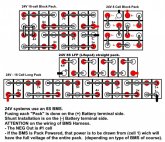Alfalfameister
New Member
- Joined
- Feb 21, 2020
- Messages
- 50
Since the bus bar that normally comes with these Alibaba cells are lacking in impressiveness and thickness or width (hmmm... where did I hear that before? Oh, nevermind), most people ask for double bus bars from the sellers, or make their own from either copper pipe or whatever...
Question about doubling the busbars (Amy of Xuba/Luyuan kindly sent me quite a few extra when I asked), if I make a 2P4S (or 8S or 16S, but 2P), do you need to double the busbars between the parallel cells?
The screws (yes, I know you can buy longer screws) can accommodate up to 3 busbars stacked on top of each other, but 4, probably not.
Is it okay to use a single busbar between the parallel cells, and just double the busbars in the series (+ to - of the next cell)?
Question about doubling the busbars (Amy of Xuba/Luyuan kindly sent me quite a few extra when I asked), if I make a 2P4S (or 8S or 16S, but 2P), do you need to double the busbars between the parallel cells?
The screws (yes, I know you can buy longer screws) can accommodate up to 3 busbars stacked on top of each other, but 4, probably not.
Is it okay to use a single busbar between the parallel cells, and just double the busbars in the series (+ to - of the next cell)?



